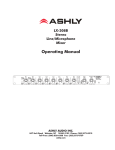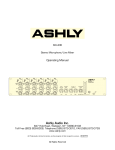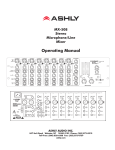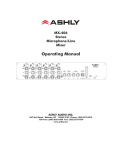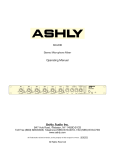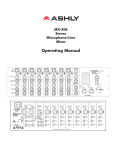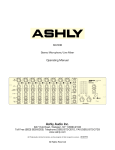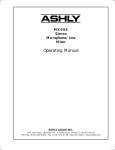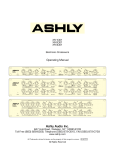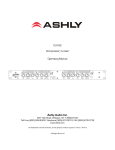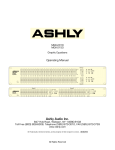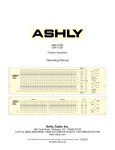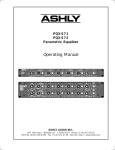Download Ashly MX-206 Specifications
Transcript
MX-206 Stereo Microphone Mixer Operating Manual ASHLY AUDIO INC. 847 Holt Road Webster, NY 14580-9103 Phone: (585) 872-0010 Toll-Free: (800) 828-6308 Fax: (585) 872-0739 ashly.com Operating Manual -MX-206 Stereo Microphone Mixer Important Safety Instructions Consignes de sécurité à lire attentivement The lightning flash with arrowhead symbol, within an equilateral triangle, is intended to alert the user to the presence of uninsulated "dangerous voltage" within the product's enclosure that may be of sufficient magnitude to constitute a risk of electric shock to persons. The exclamation point within an equilateral triangle is intended to alert the user to the presence of important operating and maintenance instructions in the literature accompanying the device. Le symbole de la flèche dans un triangle équilateral symbolisant la foudre est prévu pour sensibiliser l’utilisateur à la présence de tension de voltage non isolée à l’intérieur de l’appareil. Elle pourrait constituer un danger de risque de décharge électrique pour les utilisateurs. Le point d’exclamation dans le triangle équilatérale alerte l’utilisateur de la présence de consignes qu’il doit d’abord consulter avant d’utiliser l’appareil. 1. Read these instructions. 2. Keep these instructions. 3. Heed all warnings. 4. Follow all instructions. 5. To reduce the risk of fire or electric shock, do not expose this apparatus to rain or moisture. 6. Do not use this apparatus near water. 7. Clean only with dry cloth. 8. Do not block any ventilation openings. Install in accordance with the manufacturer’s instructions. 9. Do not install near any heat sources such as radiators, heat registers, stoves, or other apparatus. 10. Do not defeat the safety purpose of the polarized or grounding-type plug. A polarized plug has two blades with one wider than the other. A grounding type plug has two blades and a third grounding prong. The wide blade or the third prong are provided for your safety. If the provided plug does not fit into your outlet, consult an electrician for replacement of the obsolete outlet. 11. Protect the power cord from being walked on or pinched particularly at plugs, convenience receptacles, and the point where they exit from the apparatus. 12. Only use attachments/accessories specified by the manufacturer. 13. Use only with the cart, stand, tripod, bracket, or table specified by the manufacturer, or sold with the apparatus. When a cart is used, use caution when moving the cart/apparatus combination to avoid injury from tip-over. 14. Unplug this apparatus during lightning storms or when unused for long periods of time. 15. Refer all servicing to qualified service personnel. Servicing is required when the apparatus has been damaged in any way, such as power-supply cord or plug is damaged, liquid has been spilled or objects have fallen into the apparatus, the apparatus has been exposed to rain or moisture, does not operate normally, or has been dropped. 1. Lisez ces instructions. 2. Conservez ces instructions. 3. Observez les avertissements. 4. Suivez ces instructions. 5. Pour réduire le risque de feu ou la décharge électrique, ne pas exposer cet appareil pour pleuvoir ou l'humidité. 6. Ne pas utiliser l’appareil près de l’eau. 7. Le nettoyer à l’aide d’un tissus sec. 8. Ne pas bloquer les ouvertures de ventilation, installer selon les consignes du fabricant. 9. Eloigner des sources de chaleur tel: radiateurs, fourneaux ou autres appareils qui produisent de la chaleur. 10. Ne pas modifier ou amputer le système de la mise à terre. Une prise avec mise à terre comprend deux lames dont une plus large ainsi qu’une mise à terre: ne pas la couper ou la modifier. Si la prise murale n’accepte pas la fiche, consulter un électricien pour qu’il remplace la prise désuète. 11. Protéger le cordon de secteur contre tous bris ou pincement qui pourraient l’endommager, soit à la fiche murale ou à l’appareil. 12. N’employer que les accessoires recommandés par le fabricant. 13. N’utiliser qu’avec les systèmes de fixation,chariots, trépied ou autres, approuvés par le fabricant ou vendus avec l’appareil. 14. Débrancher l’appareil lors des orages électriques ou si inutilisé pendant une longue période de temps. 15. Un entretient effectué par un centre de service accrédité est exigé si l’appareil a été endommagé de quelque façon: si il a été exposé à la pluie,, l’humidité ou s’il ne fonctionne pas normalement ou qu’il a été échappé. FCC Compliance This device complies with part 15 of the FCC Rules. Operation is subject to the following two conditions: 1. This device may not cause harmful interference 2. This device must accept any interference received, including interference that may cause undesired operation Note: This equipment has been tested and found to comply with the limits for a Class B digital device, pursuant to part 15 of the FCC Rules. These limits are designed to provide reasonable protection against harmful interference in both a commercial and residential installation. This equipment generates, uses and can radiate radio frequency energy and, if not installed and used in accordance with the instructions, may cause harmful interference to radio communications. However, there is no guarantee that interference will not occur in a particular installation. If this equipment does cause harmful interference to radio or television reception, which can be determined by turning the equipment off and on, the user is encouraged to try to correct the interference by one or more of the following measures: - Reorient or relocate the receiving antenna. - Increase the separation between the equipment and receiver. - Connect the equipment into an outlet on a circuit different from that to which the receiver is connected. - Consult the dealer or an experienced radio/TV technician for help.. 2 Operating Manual - MX-206 Stereo Microphone Mixer 1. INTRODUCTION 2. UNPACKING Congratulations on your purchase of an Ashly MX206 stereo microphone mixer. In one single-space rack-mount package we have combined the features, reliability, and sonic performance you have come to expect from Ashly. This third generation mixer adds a universal 100-240VAC 50/60Hz power supply and a 3.5mm front panel stereo line input jack. As a part of our system of quality control, every Ashly product is carefully inspected before leaving the factory to ensure flawless appearance. After unpacking, please inspect for any physical damage. Save the shipping carton and all packing materials , as they were carefully designed to reduce to minimum the possibility of transportation damage should the unit again require packing and shipping. In the event that damage has occurred, immediately notify your dealer so that a written claim to cover the damages can be initiated. Other features include stereo, mono, and headphone outputs, a 20dB input pad on each channel, switchable +48V phantom power, up to 60dB of mic preamp gain (84 dB total), and concentric level and pan controls on each input channel. Ultra low-noise summing amplifiers combine the channel signals for the main outputs. Two 5-segment LED arrays monitor stereo outputs. Stereo line level outputs on 1/4" connectors, a transformer isolated 600 ohm mono output on an XLR connector, and tape/CD inputs and outputs on RCA connectors come as standard equipment. Ashly still uses professional quality 16mm metal shaft potentiometers on all controls for greater accuracy and long life. Input isolation transformers are not available on the MX-206. The right to any claim against a public carrier can be forfeited if the carrier is not notified promptly and if the shipping carton and packing materials are not available for inspection by the carrier. Save all packing materials until the claim has been settled. 3. AC POWER REQUIREMENTS The MX-206 mixer will perform normally from 100 to 240 volts AC, 50-60Hz. Use only properly grounded AC receptacles. To reduce the risk of ground loop hum, use a central point for system AC power distribution. Power consumption is 30 watts. WARNING: THIS APPARATUS MUST BE EARTHED 4. CONTROLS (see next page) 4.1 Input dB (Gain) This 3-position slide switch sets the operating level of the microphone preamp. Best signal to noise ratio is obtained with higher gain settings, however it is important to leave enough headroom (20dB) to prevent clipping. The numbers -20, -40, and -60 refer to the nominal level of the microphone signal applied to the input. In other words, more gain is needed for a weak -60dB signal than for a stronger -20dB signal, so as the switch is pushed further to the right, more gain is applied in the mic preamp circuit. The center position (-40) is a good starting point for most applications. Note: The Input Gain switch increases or decreases by 20dB increments. To avoid system feedback and possible driver or hearing damage, turn down the channel level control before adjusting the gain, then slowly increase level control to suitable setting. 4.2 Input Level This inner concentric control determines the mix level of its respective channel. If you have insufficient signal with the level fully turned up, change the Input dB (gain) switch of that channel to a higher setting (turn down level first). 4.3 Input Pan This outer concentric control determines the stereo position of the signal. 4.4 Clip Each input has a red LED which will illuminate when either the mic preamp or input level circuit pass a signal which is 3dB below clipping. If the level control is turned off and the LED is still flashing, reduce the Input dB (gain) switch. 4.5 Stereo Line In This control adjusts the level of the stereo line in signal from the RCA inputs on the back panel and the 3.5mm Stereo Line In jack on the front panel. The Stereo Line In input signal should have a nominal level of -10dB. 3 Operating Manual -MX-206 Stereo Microphone Mixer 4.6 Stereo Outputs The Left and Right output levels are independently controlled by these two dials. They respectively determine the signal at the 1/4" jack Main outputs. 4.7 Mono Output This inner concentric control determines the output level of the transformer-balanced Mono Output XLR connector. Its signal is summed from the right and left mix bus, and is fully independent of the settings of the stereo output level controls. 4.8 Headphones Output Level This outer concentric control determines the level of the stereo headphones, and is fully independent of the settings of the stereo and mono output level controls 4.9 Output Meters Two 6-segment LED arrays show the current status of the stereo outputs. 0VU is equivalent to +4dBu (1.228Vrms). 4.10 Stereo Headphone Jack You can monitor the stereo mix through headphones independent of all other output controls. In other words, the headphones can be used even if all other output controls are turned off. 4.11 Phantom Power Indicator This red LED is lit when the +48V phantom power is turned on. The phantom power switch is on the back panel. 4.12 Power Switch This switch turns on AC power to the mixer, lighting the green LED. If the switch is pressed but the LED is still off, check to see that the AC power cord is not detached. 4 5. CONNECTIONS AND CABLES The MX-206 mixer is fitted with five types of audio connectors: 3-pin XLR type male (mono output), 3-pin XLR type female (mic inputs), tip-ring-sleeve (TRS) phone jacks, RCA jack, and 3.5mm stereo TRS jack. Although using unbalanced tip-sleeve 1/4" plugs will work in certain applications, we recommend always using balanced TRS cabling for the stereo 1/4" jack outputs. Operating Manual - MX-206 Stereo Microphone Mixer Two-conductor (twisted pair) shielded cable is best for all XLR type connections. Belden No. 8412, or its equivalent, is an excellent cable due to its heavy construction. This type of cable should be used for all portable applications. Snake cables containing multiple shielded pairs must be handled very carefully because the leads tend to be fragile, and a broken conductor is difficult to repair. If low level and high level lines (e.g., microphones and mixer line outputs), or if either of these lines and speaker cables are run parallel for long distances, crosstalk may be significant. In fact, the crosstalk (signal leakage between cables) can cause an electronic feedback loop, oscillation, and possibly damage to the equipment. To minimize crosstalk, physically separate low level (microphone) cables from speaker cables by the greatest feasible distance. At any point where cables meet, run low level cables perpendicular to high level or speaker cables. If low and high level or speaker cables must be run parallel and in close proximity to one another, they should be bundled separately. 5.1 Microphone Input The microphone input is an active balanced type with a nominal impedance of 1200 ohms. Its noise performance is best with a 200 ohm microphone. The Mic input connector is a standard 3-pin XLR female with the shield on pin 1, the (+) in-phase connection on pin 2, and the (-) out-of-phase connection on pin 3. 5.2 Input Pad The Pad is a 20dB attenuation switch on the rear panel for use with each XLR microphone input. It should normally be left in the "out" position for best signal to noise ratio and should only be used when the input is being overdriven with the Input dB (gain) switch at its minimum setting. 5.3 Stereo Line In - Stereo Line Out The stereo line inputs on RCA and 3.5mm connectors have a nominal operating level of -10dBu to match most consumer level audio products. The stereo line outputs are -10dBu "pre-master", so they are not affected by the settings of the output controls. 5.4 Mono Transformer Balanced Output The mono transformer output uses a male XLR type connector and provides total isolation for 600 ohm lines. Pin 1 is ground, pin 2 is (+), and pin 3 is (-). This output is controlled by the Mono level, with a nominal operating level of +4dBu. Note: The transformer-balanced output is designed to drive up to +24dBu into a 600 ohm load. Because of the nature of an output transformer, the output level increases as the impedance of the terminating load becomes higher than 600 ohms. Whereas a "direct-coupled" output stage like that of the stereo outputs will not change as the load changes, any transformer used in an audio path is affected by its termination impedance. Since line level inputs on audio devices are typically 10KΩ or higher, expect a slight increase (2.5dB) in output level when driving high impedance inputs with the mono transformer output. The output meters will reflect the levels present on the stereo outputs, regardless of the load on the transformer output. 5.5 Stereo Outputs The Stereo Outputs are controlled by the left and right master. They are 1/4" pseudo-balanced TRS jacks with a nominal operating level of +4dBu into any load. 5 Operating Manual -MX-206 Stereo Microphone Mixer 6. TYPICAL APPLICATIONS: 6.1 Small Sound Reinforcement System: In the setup shown here, the MX-206 is used to mix typical sound sources that might be found in a small club, meeting room, school theater or similar environment. Six input channels are used for microphones for vocal or instrumental pickup. The Stereo Line In (from front or back panel input jack) and Out provide feeds to and from a laptop or other recording/playback device for playback of recorded material, or for making a recording of the mix. The main PA power amplifiers (or any additional equalizers or electronic crossovers which may be used) are fed from the Stereo Output connectors, while a stage or control room monitor is fed from the Mono Output. 6.2 Location Recording or Broadcast Mixing: In this setup the MX-206 is used to mix sources typically found in location recording or broadcast situations (mostly microphones). In this case, all six inputs are microphones, as would be used in a roundtable panel discussion. The Stereo Line In receives the output of a laptop, CD player, or other personal audio device, and the Stereo Line Out provides a feed to a recording device for making a recording of the mix. For live remote broadcast applications, the transformer-isolated Mono Output connector can feed a suitable video, telephone or press-box interface. 6.3 Submixer In Larger Sound System: In this application the MX-206 is used to upgrade an existing sound system by providing a vocal or instrumental submix to the main mixer without tying up a number of channels on the main console. This technique allows the system input capacity to be expanded without installing more buried mic cables and without changing a mixing console that everyone is already comfortable with. Use the Headphones Output to achieve a "pre-mix" before adjusting the main console. 6 Operating Manual - MX-206 Stereo Microphone Mixer 7. TROUBLESHOOTING TIPS 8. SPECIFICATIONS 7.1 No Sound Check the AC power. Is the power switch on and its LED lit? Check the level meters. If they are operating, the problem is between the mixer and the later components in the system. If there is no meter activity, check to see you really have an input signal and that it is on the desired channel. Check that you have the master gain controls at the desired operating level. INPUT IMPEDANCE Mic input (balanced) . . . . . . . . . . . . . . . . . . . . . . . . . . . . . 1.2k Ohm 7.2 Distorted Sound Something is being overdriven in the signal path. If the clip indicators are active, reduce the channel gain control and/or press in the pad switch on the rear panel. If the output level meters are constantly in the red, reduce the Master gain and increase the gain of components following the mixer. There are many gain adjustments in the mixer itself and probably several others in other system components which makes it possible to overdrive an input section and then incorrectly try to reduce the gain of the output section. The best way to approach setting gains is to establish the operating level of input stages first by setting their gain as high as possible but leaving about 20dB of headroom for loud peaks, then move on to set the master gain to produce a good meter reading. Proceed to set the gain of equalizers, limiters, crossovers, and amplifiers following the mixer in the same manner, always working toward the later stages of the system. 7.3 Excessive Noise If the noise is in the form of hiss, the problem is usually due to an input stage set up for low gain and then compensating by increasing the master gain. Check that the Pad switch is not enabled unnecessarily. Turn up the channel gain controls and reduce the master gain. 7.4 Excessive hum This is usually caused by ground loops in the system wiring. A complex sound system with many sources separated by significant distance and using several power outlets has many opportunities for this problem to occur. If possible, feed everything in the system from one power source with a common ground. Use balanced input and output connections between widely separated components. If you need help, get in touch with your Ashly dealer or call an Ashly technical service representative at 1-800-8286308. DISTORTION THD at +20 dBu, 20Hz-20KHz, input switch at -40dB . . . <0.05% IMD (SMPTE) at +20dBu, input switch at -40dB . . . . . . . . <0.02% HUM & NOISE (20Hz-20KHz) equivalent input hum and noise (input switch -60dB) . . . <-128dBu residual output noise, TRS outputs, all levels at minimum . . . . . . . . . . . . . . . . . . . . . . . . . . . . <-100dBu residual output noise, XLR outputs, . . . . . . . . . . . . . . . . . <-90dBu Master Level at nominal, all Ch. Level controls at min . . . . . . . . . . . . . . . . . . . . . . . <-84dBu Master Level and one Ch. Level at nom. . . . . . . . . . . . . . . <-80dBu MAXIMUM VOLTAGE GAIN (±2dB) Mic Input to Master Output, 600 ohm load . . . . . . . . . . . . . . . 84dB Aux In to Master Output . . . . . . . . . . . . . . . . . . . . . . . . . . . . . . 28dB MAXIMUM INPUT LEVEL Mic input (with pad) . . . . . . . . . . . . . . . . . . . . . . . . . . . . +22.3dBu MAXIMUM OUTPUT LEVEL Transformer output . . . +24.2dBu @600 Ohm (+26.7dBu no load) Line output . . . . . . . . . . . . . . . . . . . . . . . . +23dBu, RCA +13.5dBu FREQUENCY RESPONSE 20Hz-20KHz . . . . . . . . . . . . . . . . . . . . . . . . . . . . . . . . . . +0/-0.5dB CROSSTALK Between any inputs or outputs 20Hz-20KHz . . . . . . . . . . . . . . . . . . . . . . . . . . . . . . . . . . . . . <-60dB VU METERS Two 5-segment LED meters . . . . . . . . . . . . . . . . . . . 0VU = +4dBu PEAK INDICATORS Peak Clip indicator on each input channel and left and right outputs, illuminates 3dB below clipping PHANTOM POWER +48 VDC applied to all Mic Inputs, switchable on front panel. Maximum total current draw = 80mA. Maximum single channel current draw = 14mA. Gradual power-up and down to eliminate "pops". WEIGHT unit weight . . . . . . . . . . . . . . . . . . . . . . . 6.8 lbs. (3.1kg) maximum shipping weight . . . . . . . . . . . . . . . . . . 10.1 lbs. (4.58kg) maximum DIMENSIONS 19"W (48.3) by 9.4"D (23.9) by 1.75"H (4.45) POWER REQUIREMENTS 100-240 VAC, 50-60 Hz, 30 Watts *unless otherwise stated, specification conditions are: 150Ω source, Input set at "-40", all other controls set at nominal, XLR output into 600Ω or greater. 7 Operating Manual - MX-206 Stereo Microphone Mixer LIMITED WARRANTY (USA ONLY) (Other countries please contact your respective distributor or dealer.) For units purchased in the USA, warranty service for this unit shall be provided by ASHLY AUDIO, INC. in accordance with the following warranty statement. ASHLY AUDIO, INC. warrants to the owner of this product that it will be free from defects in workmanship and materials for a period of FIVE years from the original-date-of-purchase. ASHLY AUDIO INC. will without charge, repair or replace at its discretion, any defective product or component parts upon prepaid delivery of the product to the ASHLY AUDIO, INC. factory service department, accompanied with a proof of original-date-of-purchase in the form of a valid sales receipt. This warranty gives you specific legal rights, and you may also have other rights, which vary from state to state. EXCLUSIONS: This warranty does not apply in the event of misuse, neglect, or as a result of unauthorized alterations or repairs made to the product. This warranty is void if the serial number is altered, defaced, or removed. ASHLY AUDIO, INC. reserves the right to make changes in design, or make additions to, or improvements upon, this product without any obligation to install the same on products previously manufactured. Any implied warranties, which may arise under the operation of state law, shall be effective only for FIVE years from the original-date-of-purchase of the product. ASHLY AUDIO, INC. shall be obligated to only correct defects in the product itself. ASHLY AUDIO, INC. is not liable for any damage or injury, which may result from, or be incidental to, or a consequence of, such defects. Some states do not allow limitations on how long an implied warranty lasts, or the exclusion, or limitation of incidental or consequential damages, so the above limitations or exclusions may not apply to you. OBTAINING WARRANTY SERVICE: For warranty service in the United States, please follow this procedure: 1) Return the product to ASHLY AUDIO, INC. freight prepaid, with a written statement describing the defect and application that the product is used in. ASHLY AUDIO, INC. will examine the product and perform any necessary service, including replacement of defective parts, at no further cost to you. 2) Ship your product to: ASHLY AUDIO, INC. Attention: Service Department 847 Holt Road Webster, NY 14580-9103 ASHLY AUDIO INC. 847 Holt Road Webster, NY 14580-9103, USA Phone: (585) 872-0010 Fax: (585) 872-0739 Toll Free (800) 828-6308 ashly.com ©2014 by Ashly Audio Corporation, a division of Jam Industries Ltd. All rights reserved worldwide. All features, specifications, and graphical representations are subject to change or improvement without notice. Printed in USA MX206 R0614








